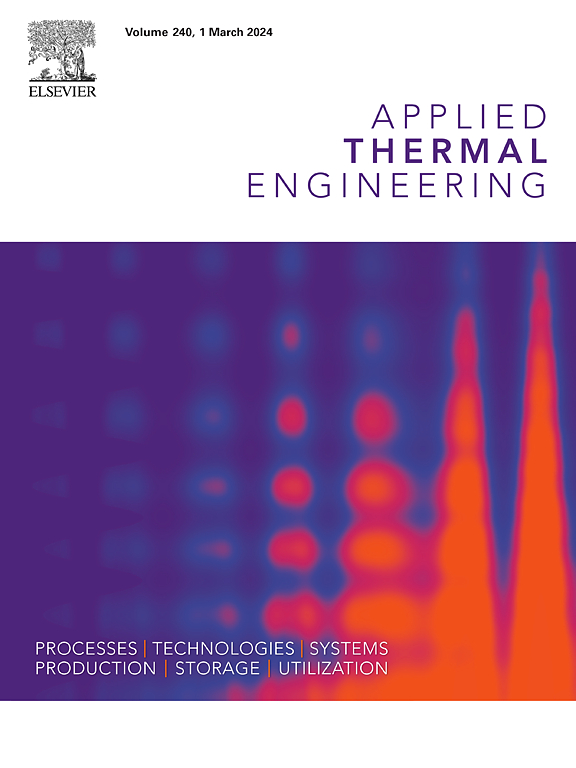富氧燃烧诱发页岩气爆炸临界氧浓度的实验和数值研究
IF 6.1
2区 工程技术
Q2 ENERGY & FUELS
引用次数: 0
摘要
利用富氧燃烧诱发爆轰(OEC-DET)来改善谢尔金螺旋提高超压的缺点,还很少有人涉及。为了揭示 OEC-DET 的动力学机制和临界条件,我们进行了系统的实验和模拟。实验选择含氮量分别为 4% 和 20% 的龙马溪(LMX)和寒武纪(HWX)页岩气作为燃料。在 90 L 的多相燃料爆管中测试了不同氧浓度下 0.8、1.0 和 1.2 等效比燃料的爆炸超压历史。然后通过动力学模拟补充了燃烧反应的温度敏感系数。结果表明,OEC-DET 是 OEC 产生的 H2O 的液-气相转变促进压力波发展的一种表现形式。其基本机制之一是氧气浓度的增加提高了温度敏感性和 H2O 生成速率,从而有利于 OEC-DET 的发生。据测定,页岩气中 OEC-DET 的临界氧浓度(COC)约为 25%-30%。氮含量和当量比越低,临界氧浓度就越低。随着 COC 的增加,爆炸超压和压力上升率都呈现分段线性增长和指数增长,特别是在 OEC-DET 之后,增长趋势变得更快。因此,得出了两个 COC 预测方程,其准确率超过 90%,这为原地甲烷爆燃压裂等热工工程提供了启示。本文章由计算机程序翻译,如有差异,请以英文原文为准。
Experimental and numerical study on critical oxygen concentration for shale gas detonation induced by oxygen-enriched combustion
To improve the shortcomings of Shchelkin spiral in enhancing overpressure utilizing oxygen-enriched combustion-induced detonation (OEC-DET) has seldom been touched upon. Systematic experiments and simulations have been conducted to reveal the kinetic mechanism and critical conditions of OEC-DET. Longmaxi (LMX) and Cambrian (HWX) shale gases with 4 % and 20 % nitrogen content were selected as fuels. Explosion overpressure histories of 0.8, 1.0 and 1.2 equivalence ratio fuels at different oxygen concentrations were tested in a 90 L multiphase fuel detonation tube. Temperature sensitivity coefficients of combustion reactions were then supplemented by kinetic simulations. OEC-DET was demonstrated to be a manifestation of pressure wave development promoted by liquid–gas phase transition of H2O produced by OEC. One underlying mechanism is that the increase in oxygen concentration enhances the temperature sensitivity and H2O production rate, thus favoring the occurrence of OEC-DET. The critical oxygen concentration (COC) of OEC-DET in shale gas has been determined to be around 25 %–30 % herein. The lower the nitrogen content and equivalence ratio, the lower the COC. Both the explosion overpressure and pressure rise rate exhibit segmented linear and exponential growth with the increase of COC, and particularly the growth trend becomes accelerated after OEC-DET. Two COC prediction equations have thus been derived with an accuracy exceeding 90 % and these shed light on the thermal engineering such as in-situ methane deflagration fracturing.
求助全文
通过发布文献求助,成功后即可免费获取论文全文。
去求助
来源期刊

Applied Thermal Engineering
工程技术-工程:机械
CiteScore
11.30
自引率
15.60%
发文量
1474
审稿时长
57 days
期刊介绍:
Applied Thermal Engineering disseminates novel research related to the design, development and demonstration of components, devices, equipment, technologies and systems involving thermal processes for the production, storage, utilization and conservation of energy, with a focus on engineering application.
The journal publishes high-quality and high-impact Original Research Articles, Review Articles, Short Communications and Letters to the Editor on cutting-edge innovations in research, and recent advances or issues of interest to the thermal engineering community.
 求助内容:
求助内容: 应助结果提醒方式:
应助结果提醒方式:


